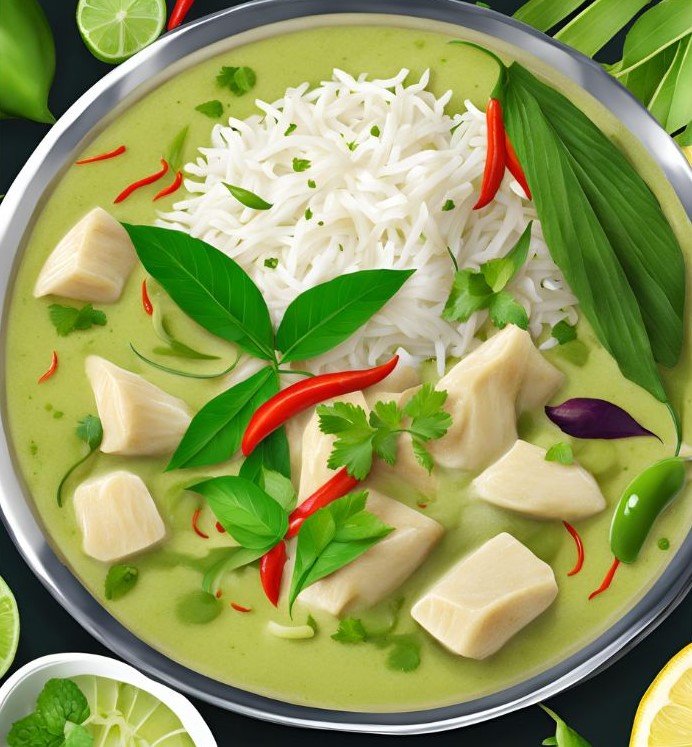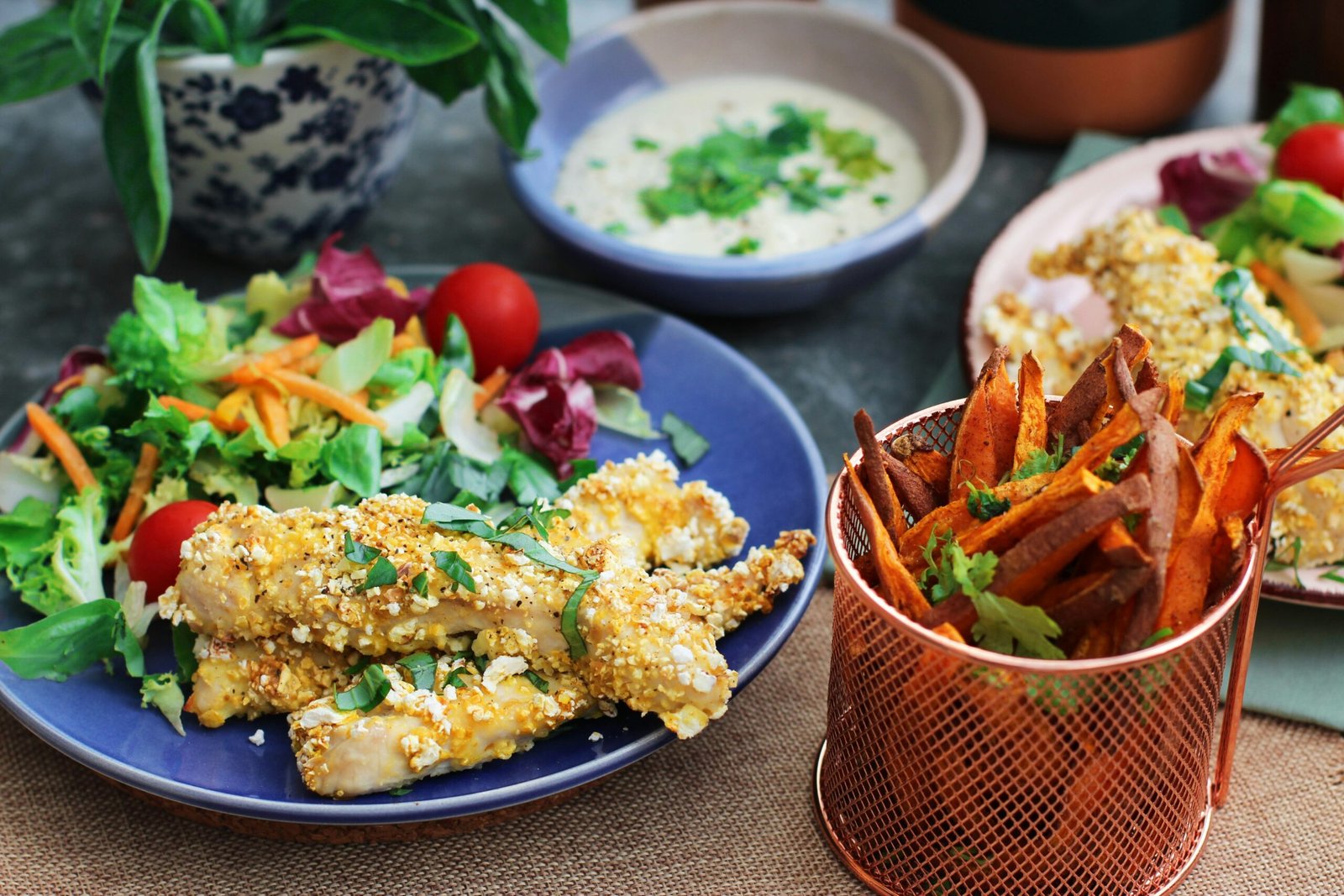Introduction to Green Curry
Green curry, known as “Gaeng Keow Wan” in Thai, is a vibrant and aromatic dish that showcases the unique flavors and culinary heritage of Thailand. Originating from Central Thailand, this green curry recipe is recognized for its strikingly bright color and its ability to balance sweetness, spiciness, and savoriness, making it a quintessential element of Thai cuisine. Influenced by the region’s abundance of fresh herbs and spices, green curry offers a delightful culinary experience that continues to attract food lovers worldwide.
The characteristic hue of green curry comes primarily from green chili peppers and fresh herbs such as basil, cilantro, and kaffir lime leaves. The base of the dish is typically crafted from green curry paste, which merges these ingredients with galangal, lemongrass, and garlic, resulting in a complex and fragrant flavor profile. The addition of coconut milk not only enhances the dish’s creamy consistency but also balances the spiciness of the green chilies, creating an inviting contrast.
Another appealing aspect of this dish is its adaptability, allowing for a variety of proteins and vegetables. Whether you prefer chicken, seafood, or a vegetarian option, the Thai green curry recipe can be tailored to suit different dietary preferences. Served alongside jasmine rice or noodles, green curry has firmly established itself as a beloved staple not just in Thailand but also in various international culinary scenes. Its rich flavor and healthful ingredients encourage individuals to recreate this enticing dish at home, embarking on a flavorful journey that captures the essence of Thailand. Readers are invited to explore the nuances of this delightful dish and learn to craft their own version, delving into the joy of cooking Thai green curry.
Essential Ingredients for Your Green Curry
To create an authentic and flavorful green curry, it is paramount to gather the right ingredients that contribute to its unique taste profile. The key ingredient in any thai green curry recipe is undoubtedly green curry paste. This paste is a blend of green chilies, garlic, shallots, lemongrass, and spices, which provides the dish with its characteristic heat and aromatic flavor. When selecting green curry paste, it is advisable to look for variations that suit your spice tolerance; many brands offer milder versions, while others pack a more pungent punch. For those preferring homemade adjustments, a simple recipe can incorporate fresh green chilies blended with ginger or coriander for additional freshness.
Coconut milk is another essential component that not only enhances the curry’s rich creamy texture but also balances the spiciness of the green curry paste. When making a thai green curry, opt for full-fat coconut milk for a more decadent dish, though light coconut milk can serve as a healthier substitute. Factoring in dietary preferences, you may also consider using other plant-based milks, such as almond or oat milk, keeping in mind how these alternatives might alter the flavor overall.
Incorporating fresh herbs, particularly Thai basil and cilantro, is vital for garnishing your green curry, lending a fresh, aromatic finish. These herbs can be substituted with more widely accessible varieties like sweet basil if necessary. Additionally, a variety of vegetables enhances your dish’s nutritional value. Common choices include bell peppers, zucchini, and eggplant, but feel free to explore others like bamboo shoots or baby corn for added texture.
Overall, when creating your own green curry recipe, experimenting with different ingredients allows you to tailor the dish to your taste and dietary needs while keeping the essence of traditional Thai flavors intact.
Step-by-Step Cooking Instructions
To create a delicious Thai green curry, it is essential to follow a precise set of steps to ensure the flavors meld beautifully. Begin by gathering your ingredients: fresh vegetables, your choice of protein (such as chicken, tofu, or shrimp), and, of course, the crucial element—a homemade or store-bought green curry paste. The balance of flavors in any green curry recipe heavily relies on the quality of the green curry paste used.
Once you have your ingredients ready, start by preparing the vegetables. This might include slicing bell peppers, cutting eggplants into bite-sized pieces, and chopping fresh herbs such as Thai basil. If you’re using proteins, ensure they are cut into uniform pieces for even cooking. Once everything is prepared, heat a tablespoon of vegetable oil in a large pan or wok over medium heat.
Next, add the green curry paste to the heated oil. Sauté it gently for about 1-2 minutes until it becomes fragrant, releasing its aromatic oils. This step is crucial as it forms the base of your Thai green curry. Afterward, pour in coconut milk, stirring well to combine it with the curry paste. Allow this mixture to simmer for a few minutes to develop a rich flavor.
Once the coconut milk and curry paste have integrated, add the protein to the pan. Allow it to cook through, which should take around 5-7 minutes. After the protein is nearly cooked, add in your prepped vegetables. The cooking time will depend on the type of vegetables you have chosen; typically, they will take an additional 5 to 10 minutes to become tender yet retain their vibrant colors and crunch.
After everything is properly cooked, taste your Thai green curry for seasoning. You can balance flavors by adding a splash of fish sauce, a hint of sugar, or fresh lime juice to elevate the dish. Serve your green curry hot with a side of jasmine rice or rice noodles, garnished with fresh herbs for a visually appealing presentation. This careful and methodical approach ensures that your green curry recipe turns out perfectly every time.
Serving Suggestions and Variations
Thai green curry is a versatile dish that offers a delightful blend of flavors and textures. When serving your green curry recipe, consider pairing it with a side of jasmine rice, which absorbs the aromatic curry sauce beautifully. For those who prefer a lower-carb option, cauliflower rice or quinoa can serve as excellent alternatives. These sides not only complement the dish but also enhance the overall dining experience.
To further elevate your meal, incorporate fresh vegetables on the side, such as steamed broccoli, bok choy, or sugar snap peas. These options add a refreshing crunch and balance the richness of the green curry. Additionally, consider offering a simple cucumber salad dressed in vinegar for a bright, tangy contrast.
Variations of the classic Thai green curry recipe allow for customization according to personal dietary preferences. For vegetarian choices, tofu or tempeh can be substituted for meat, while incorporating a mix of colorful vegetables like bell peppers, zucchini, or eggplant. This not only preserves the authenticity of the green curry paste but also provides a hearty meal which appeals to a wide range of diners.
If you’re looking for a protein-rich option, chicken, shrimp, or beef can be integrated into your green curry recipe, enhancing its flavor profile while providing a satiating meal. Each variation maintains the vibrant essence of the original dish, leaving room for exploration based on your taste preferences.
When it comes to storing leftovers, place any remaining curry in an airtight container, refrigerating for up to three days. To reheat, gently warm it on the stovetop, adding a splash of coconut milk if necessary to restore its creamy texture. This method ensures that the flavors remain intact, allowing you to enjoy your flavorful journey to Thailand time and again.


